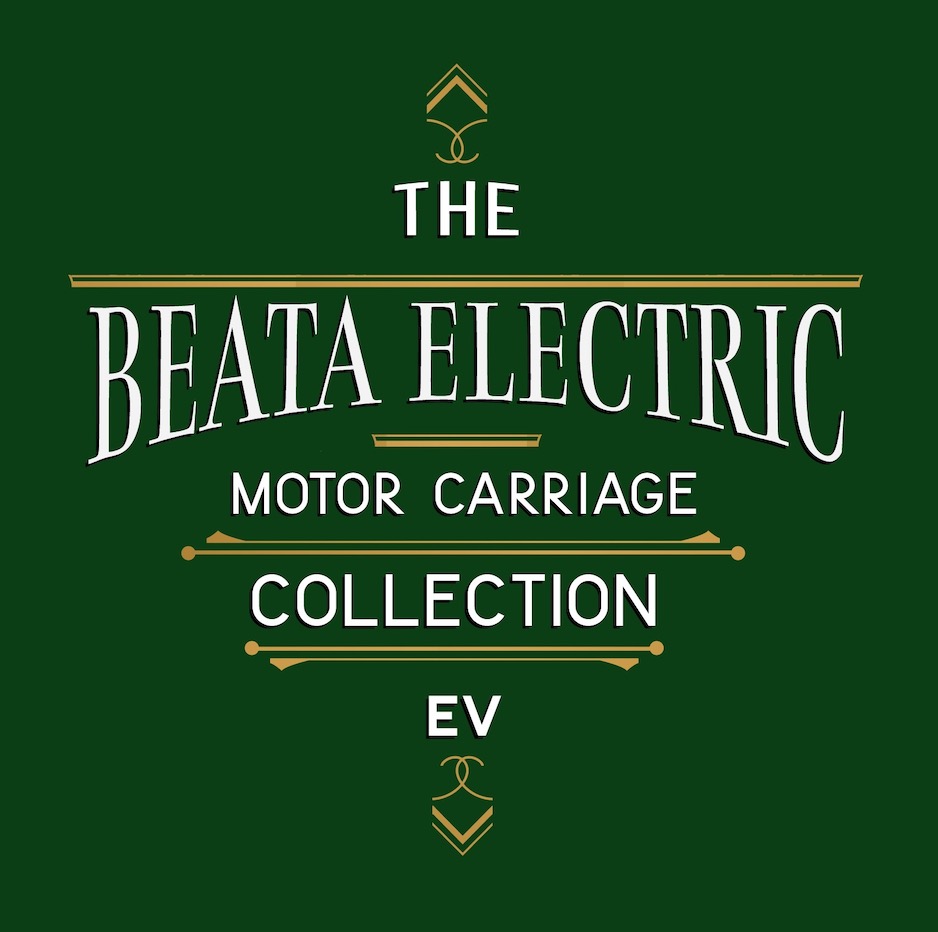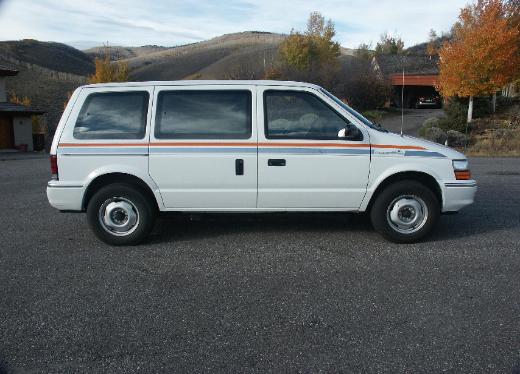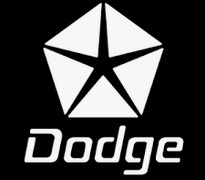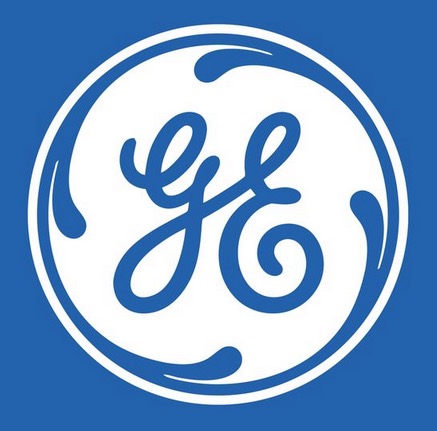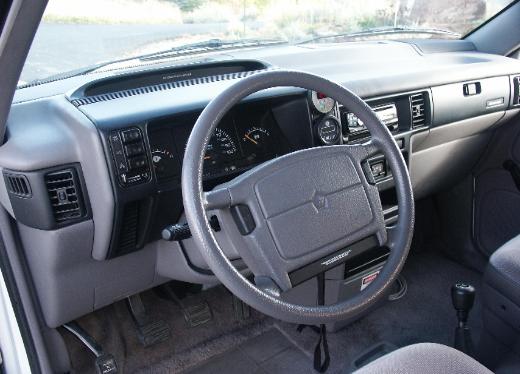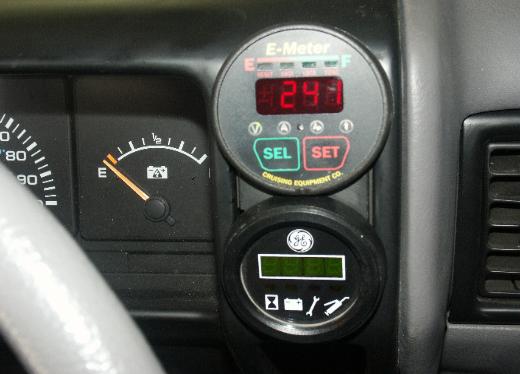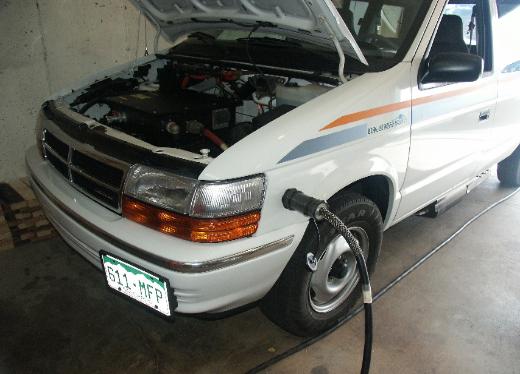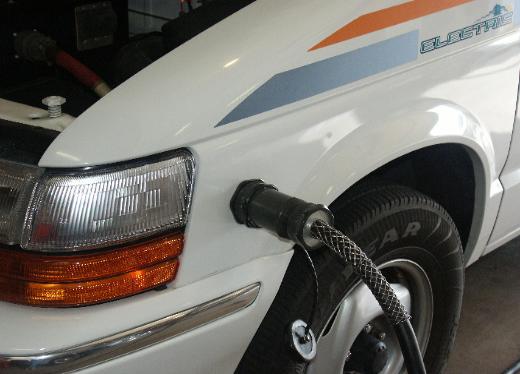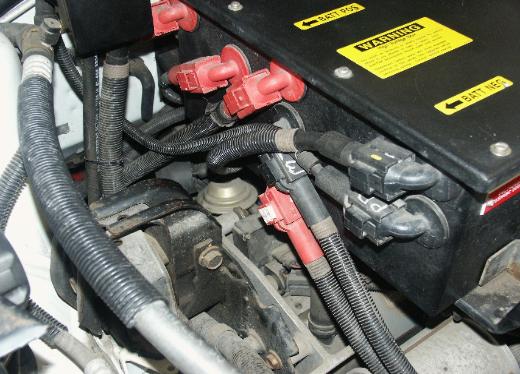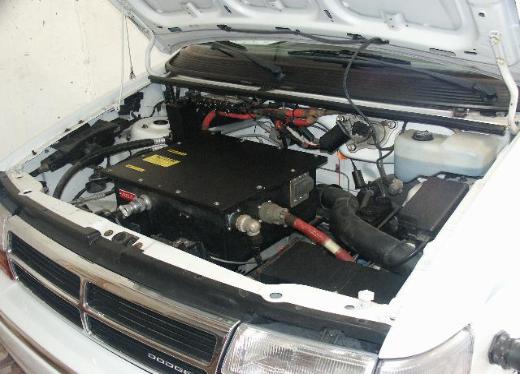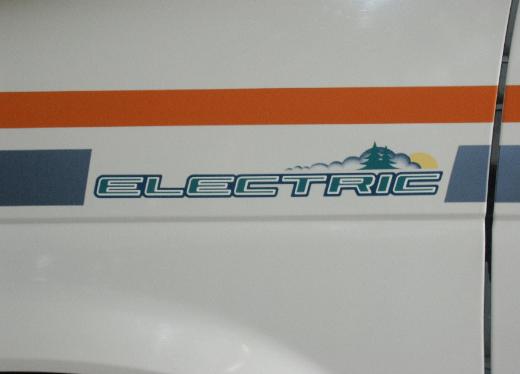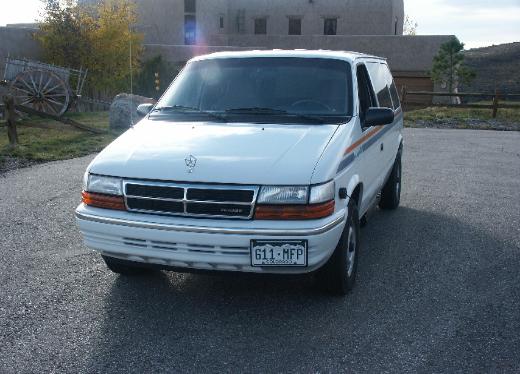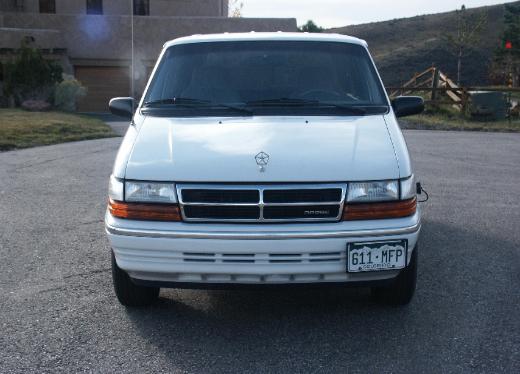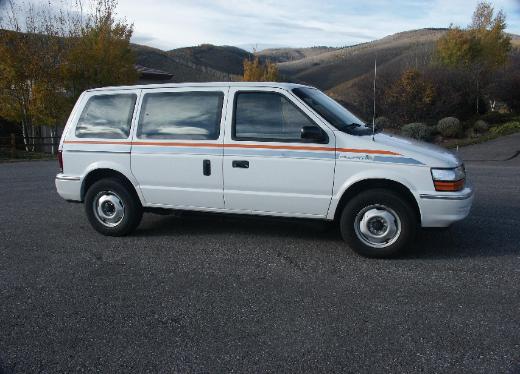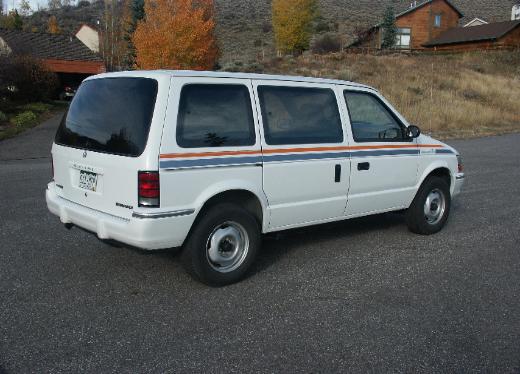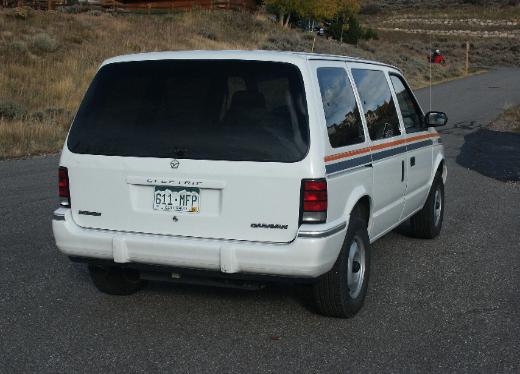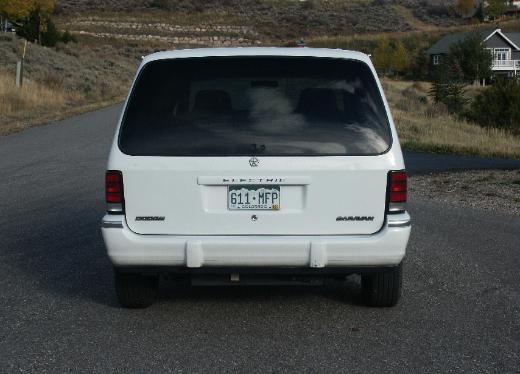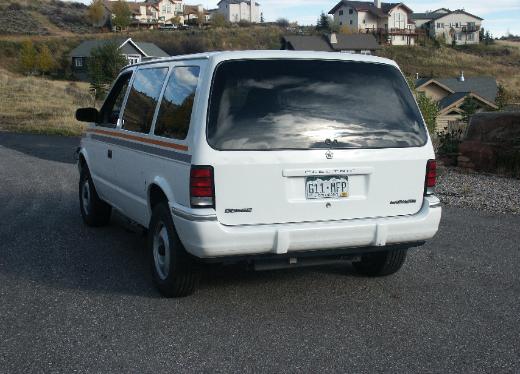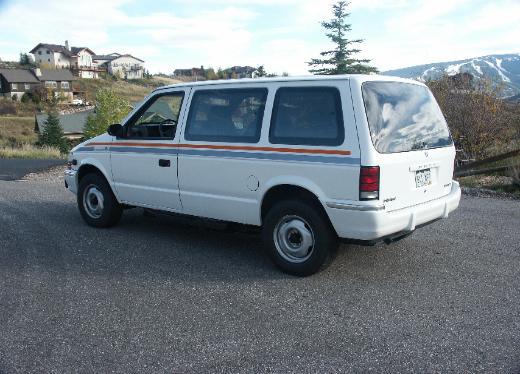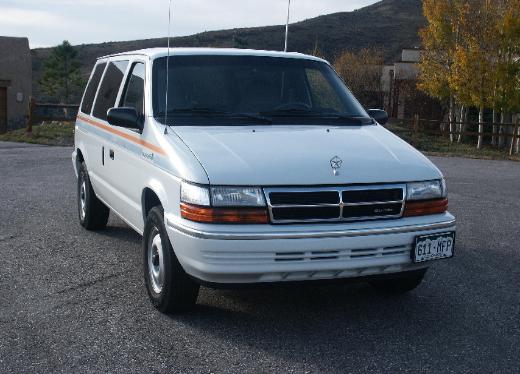
1993 Dodge OEM EV
" TEVan "
---> Traction Electric Van <---
===
Vehicle Description
The TEVan is a full size ZEV (zero emission vehicle) and is one
of 56 full sized electric vehicles purpose built by
Chrysler Corporation on the 1993 Caravan platform. These
vehicles were built at Chrysler's Windsor Ontario,
Canada, plant on the same assembly line as the ICE powered
Caravan. The TEVan was sold primarily to Electric Utilities
and was not made available to the public, although a few examples
have fallen into private hands over the years. The TEVan's
original dealer sticker price was US$120K in 1993,
although Chrysler reported that actual production costs fell between
US$250K and $300K per vehicle at the time.
Standard equipment on the TEVan included: Heating & Air
Conditioning, Power Steering, Power Brakes and seating for 5
passengers plus luggage. Two battery types were used in the TEVan
production. 1) The Eagle-Picher Nife (Nickle-Iron) model
NIF-200. These units were 200 amp hour batteries with 30 units
@ 5 cells per unit fitted in the pack; and 2), the SAFT
flooded NiCd batteries which were also estimated to last for
100,000 miles or greater than 20 years. Both battery
types have an automatic battery watering system
that is integrated with the charging system. The TEVan’s on-board
charger is a PFC (Power Factor Corrected) Martin-Marietta
and accepts a) 120vac @ 20 amps; b) 220vac @ 20 or 40 amps;
and c) a 208 three phase @ 20 or 40 amp inputs. The
charger is incorporated into the vehicle’s controller housing.
The TEVan uses a 27 hp, 70 hp max (48 kW) separately-excited
General Electric DC traction motor coupled to a two-speed
FWD EV trans-axle that featured hi, lo, reverse and park; and is
a highway capable vehicle with speeds up to 70 mph. The
owner's manual referres to it as a 'semi-automatic transmission'
although it uses a typical clutch system. The motor
controller was also manufactured by General Electric. The TEVan
has a curb weight of 5,060 lbs.
The TEVan has an 8.8 kW three-stage ceramic electric
heater. The 120A DC/DC converter provided all the 12v power,
there is no auxiliary (12V) battery. Gauges included motor
temperature and SOC (state of charge, akin to "Fuel Level")
using the stock instruments. The collection's TEVan is fitted with
an E-Meter and a GE LXT diagnostic gauge added to the
dash. It is also equipped with electric air conditioning (R-134a),
regenerative braking, power brakes using a Delco
electric vacuum pump, power steering, AM/FM Stereo, and
airbags. The original equipment tires were LRR, (Low Rolling
Resistance), Goodyear P205/75R15 Momentum at 50PSI.
----- NiFe vs. NiCd Battery Chemistries -----
===
NiFe Details
The 180v nickel-iron (NiFe) battery pack consists of 30
Eagle-Picher 6v NIF-200 200Ah batteries in six removable
pods under the floor of the car, delivering a 90 mile
range according to the owner's manual. 60 to 80 miles of range
is a more pratical estimate depending on driving conditions.
The nickel-iron battery is a storage battery having a
Nickel (III) oxide-hydroxide cathode and an iron anode, with
an electrolyte of potassium hydroxide (KOH). The nominal cell
voltage is 1.2V. It is a very robust battery which is tolerant
of abuse, (overcharge, over discharge, short-circuiting
and thermal shock) and can have very long life even if so treated.
It is often used in backup situations where it can be
continuously charged and can last for well over 20 years. Its
limitations include low specific energy, poor charge retention, poor
low-temperature performance, a low energy-to-weight ratio,
and its high cost of manufacture. The ability of these
batteries to survive frequent cycling is due to the low solubility
of the reactants in the electrolyte. The formation of metallic
iron during charge is slow because of the
low solubility of the Fe3O4, which is good and bad. It is good
because the slow formation of iron crystals preserves the electrodes,
bad because it limits the high rate performance: these
cells charge slowly, and give it up slowly.
Edison batteries are known to perform stronger the more they
are cycled. Even following long periods of non-use these units can
be awakened through repeated charge and
discharge cycles. Although the TEVan’s watering system is designed
to pump overflow KOH back into the batteries
on subsequent watering cycles, the KOH electrolyte can and
should be replenished from time to time to maintain
optional performance.
Nickel-iron batteries have long been used in European mining
operations because of their ability to withstand vibrations,
high temperatures and other physical stress. They have also been
utilized in wind and solar power system applications
and for electric early vehicle applications.
----- NiFe Battery History -----
In 1899 Swedish inventor Waldemar Jungner invented the
nickel–cadmium (NiCd) and subsequently the nickel–iron (NiFe)
batteriy chemistries in 1899. With the NiCd coming first, Jungner
experimented with substituting iron for the cadmium in
varying proportions, including 100% iron to form the NiFe chemistry.
Jungner discovered that the main advantage over the
nickel–cadmium chemistry was cost, but due to the lower efficiency
of the NiFe charging reaction and more pronounced formation
of hydrogen (gassing), the nickel–iron technology was found
wanting and abandoned. Jungner had completed several
Swedish patents for the iron version of this battery.
Subsequently, in 1901 Thomas Edison patented and
commercialized NiFe in the United States and offered it as the
energy source for early electric vehicles, such as
the Detroit Electric (1907 - 1939). Edison made claims for his
nickel-iron design, claiming them to be, "... far superior to batteries
using lead plates and acid". Edison's batteries were made from
about 1903 to 1972 by the Edison Battery Storage
Company located in East Orange, NJ. They were quite profitable
for the company. In 1972 the battery company was sold to
the Exide Battery Corporation. Exide continued to manufacture the
battery until 1975, then abruptly discontinued making the battery.
Edison was disappointed that his battery was not adopted
for starting internal combustion engines and that electric vehicles
went out of production only a few years after his battery
was introduced. He actually developed the battery to be the
battery of choice for electric vehicles which he thought would be
the preferred transportation mode in the early 1900's. The
battery enjoyed wide use for railroad signaling, fork lift, and standby
power applications. There are no Nickel Iron batteries
manufactured in the Western world (c2006), but they are still
manufactured in China.
===
NiCd Details
The 180v nickel-cadnium (NiCd) battery pack consists of 30
SAFT STM5-180 6v Flooded 180Ah batteries configured in six
removable pods under the floor of the TEVan. xxx ...
(NiCd data under construction)
===
----- Other Chrysler EV History -----
The second generation of this vehicle, designated the EPIC
(Electric Powered Intraurban Commuter), was launched
in 1997 with advanced lead acid batteries and later in 1998 with
NiMH battery chemistry. The EPIC utilized an
AC traction motor and single speed transmission as opposed to
the SepEx DC traction motor and two speed transmission
of the TEVan. Unlike the TEVan which was sold outright to major
untility companies, the EPIC was only offered for
lease in New York and California in 1999, with a few sold
out right to government agencies.
Along with the collection's two TEVans, one with
NiFe battery chemistry and a second with NiCd chemistry, the
collection also holds an example of the 1999 EPIC
as listed in a seperate section.
---> Additional pictures below <---


